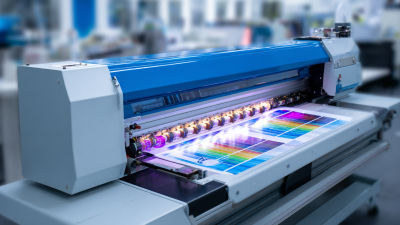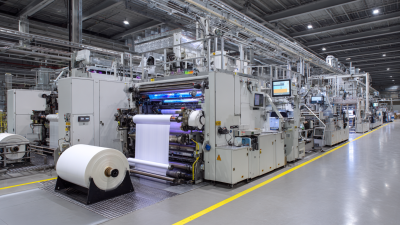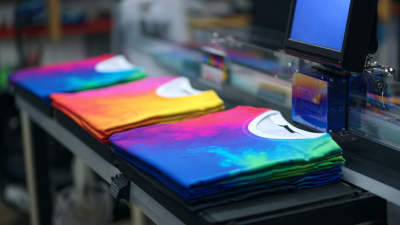 In the ever-evolving landscape of modern packaging solutions, the introduction of the Sleeve Printing Machine has emerged as a transformative force. This innovative technology has revolutionized the way brands approach packaging design, offering unparalleled flexibility and efficiency. Unlike traditional printing methods, sleeve printing allows for high-quality graphics to be applied directly onto varied container shapes, providing a seamless and attractive finish.
In the ever-evolving landscape of modern packaging solutions, the introduction of the Sleeve Printing Machine has emerged as a transformative force. This innovative technology has revolutionized the way brands approach packaging design, offering unparalleled flexibility and efficiency. Unlike traditional printing methods, sleeve printing allows for high-quality graphics to be applied directly onto varied container shapes, providing a seamless and attractive finish.
The adaptability of Sleeve Printing Machines means they can accommodate short runs and diverse materials, catering to the dynamic demands of today’s market. As businesses increasingly prioritize sustainability and aesthetic appeal, understanding the capabilities and advantages of sleeve printing technology becomes essential for staying competitive. This exploration delves into how Sleeve Printing Machines are not just tools, but crucial players in redefining packaging standards, enhancing brand visibility, and meeting consumer expectations in a rapidly changing environment.
The evolution of sleeve printing technology has significantly transformed the packaging industry, offering an efficient and versatile solution for various packaging needs. Historically, traditional printing methods were limited in design capability and adaptability. However, advancements in sleeve printing have allowed brands to leverage high-quality, full-color graphics that can easily wrap around containers of different shapes and sizes. According to a report from Smithers Pira, the global market for sleeve labels is expected to grow at a CAGR of 4.9% from 2020 to 2025, underscoring the increasing preference for this printing method.
Moreover, sleeve printing technology offers unparalleled benefits in sustainability. As businesses strive to reduce waste, the efficiency of sleeve printing minimizes leftover materials and ink consumption. A survey by the Packaging Association revealed that 64% of consumers prefer brands that utilize eco-friendly packaging solutions, showcasing a significant market trend that sleeve printing effectively addresses.
**Tips:** When considering sleeve printing for your packaging solutions, ensure to choose materials that are recyclable or biodegradable. Additionally, take advantage of digital printing technology to customize designs quickly and test different graphics with less waste. This approach can enhance your brand's appeal while remaining environmentally responsible.
| Dimension | Details |
|---|---|
| Technology Type | Digital Sleeve Printing |
| Print Resolution | Up to 1200 DPI |
| Material Compatibility | Plastic, Shrink Film, Labels |
| Production Speed | Up to 300 meters per minute |
| Sustainability | Reduced waste and energy consumption |
| Color Range | CMYK + Custom Colors |
| Market Applications | Food & Beverage, Cosmetics, Electronics |
| Print Area Size | Customizable up to 3 meters |
| User-Friendliness | Intuitive Interface and Design Software |
| Maintenance | Low maintenance requirements with high uptime |
Sleeve printing machines have revolutionized the packaging industry by offering flexibility and efficiency that traditional printing methods cannot match. One of the key advantages of using sleeve printing technology is its ability to accommodate a wide variety of shapes and sizes. This is especially important as brands seek to create unique packaging that stands out on crowded shelves. According to industry reports, sleeve labels now command a significant share of the packaging market, due in part to their ability to stretch and conform to complex designs without compromising print quality.
Furthermore, sleeve printing machines operate at higher speeds compared to conventional methods, resulting in reduced lead times and increased productivity. This efficiency is crucial in today’s fast-paced market where consumer preferences can change rapidly. A recent analysis highlighted that businesses using sleeve printing technology can yield up to 30% more output while maintaining lower operational costs.
**Tips:** When considering the transition to sleeve printing, evaluate your product’s packaging requirements and the potential for customized designs. Investing in high-quality sleeve printing machines can significantly enhance your branding efforts. Additionally, keep an eye on advancements in machine learning that could further optimize the efficiency of these technologies in the future.
 Sleeve printing machines are revolutionizing the packaging industry, especially in their impact on branding and aesthetics. According to a report by Smithers Pira, the global printed plastic packaging market is projected to reach $400 billion by 2025, with sleeve labeling being a significant contributor. This innovative printing method allows for full-body graphics that can wrap around the entire container, providing brands with a larger canvas to tell their stories and engage consumers.
Sleeve printing machines are revolutionizing the packaging industry, especially in their impact on branding and aesthetics. According to a report by Smithers Pira, the global printed plastic packaging market is projected to reach $400 billion by 2025, with sleeve labeling being a significant contributor. This innovative printing method allows for full-body graphics that can wrap around the entire container, providing brands with a larger canvas to tell their stories and engage consumers.
One of the standout benefits of sleeve printing is its ability to produce high-quality, vibrant designs that enhance product visibility on crowded shelves. Research from the Packaging Association indicates that 70% of purchasing decisions are made at the point of sale, underscoring the importance of eye-catching packaging. With sleeve printing, brands can achieve intricate designs, bold colors, and textures that not only attract attention but also convey the brand's identity effectively. Furthermore, the flexibility and adaptability of sleeve printing cater to various container shapes and sizes, allowing brands to maintain consistency across their product lines while remaining competitive in an evolving market.
Sleeve printing machines are revolutionizing packaging solutions by significantly enhancing sustainability. As consumer awareness around environmental issues grows, the demand for eco-friendly packaging options has led to innovations in sleeve printing technologies. With the stretch and shrink sleeves market projected to reach USD 16.5 billion by 2024, there’s a clear indication of the shift towards more versatile and sustainable solutions. These sleeves not only improve product visibility but also reduce material waste through their efficient usage, aligning perfectly with the current trends prioritizing sustainability.
Tips for incorporating sleeve printing sustainably include selecting biodegradable or recyclable materials for your sleeves. Additionally, consider optimizing your production processes to minimize energy consumption and waste generation. Keeping up with technological advancements can also significantly improve your environmental footprint, as many new printing technologies focus on reducing harmful emissions and improving the recyclability of materials.
Moreover, the emphasis on emotional engagement in product marketing cannot be overlooked. Innovative packaging designs that integrate sensory appeal create a "wow" factor, making products stand out on the shelf. Sustainable packaging not only appeals to the environmentally conscious consumer but also enhances brand loyalty in a competitive market, illustrating that sustainability is not just a trend but a fundamental shift in consumer behavior.
The future of sleeve printing in packaging is poised for exciting transformations, driven by the growing demand for innovative, cost-effective, and visually appealing packaging solutions. As businesses increasingly adopt heat-shrink sleeve labels, the market is projected to witness significant growth, with estimates suggesting that by 2032, the global market size for heat-shrink sleeve labels could reach substantial figures, reflecting a compound annual growth rate (CAGR) influenced by various materials like polyethylene, polyvinyl chloride, and polyethylene terephthalate.

One of the key trends in sleeve printing technology is the advancement in printing techniques that enhance the ability to produce high-quality graphics and complex designs while optimizing operational efficiency. As consumer preferences shift towards sustainability, sleeve printing technologies are also evolving to incorporate eco-friendly materials and printing inks, which align with the increasing regulatory pressure on manufacturers to adopt sustainable practices. The integration of automation within the sleeve printing process is likely to further reduce production times and costs, enabling brands to respond swiftly to market demands and consumer expectations, ultimately redefining conventional packaging standards.






